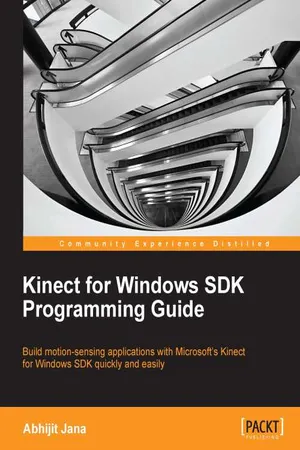![]()
Kinect for Windows SDK Programming Guide
![]()
Table of Contents
Kinect for Windows SDK Programming Guide
Credits
About the Author
Acknowledgement
About the Reviewers
www.PacktPub.com
Support files, eBooks, discount offers and more
Why Subscribe?
Free Access for Packt account holders
Instant Updates on New Packt Books
Preface
What this book covers
What you need for this book
Who this book is for
Conventions
Reader feedback
Customer support
Downloading the example code
Errata
Piracy
Questions
1. Understanding the Kinect Device
Components of Kinect for Windows
Inside the Kinect sensor
The color camera
IR emitter and IR depth sensor
How depth data processing works
Tilt motor
Microphone array
LED
Kinect for Windows versus Kinect for Xbox
Where can you use Kinect
Summary
2. Getting Started
System requirements for the Kinect for Windows SDK
Supported operating systems
System configuration
The Kinect sensor
The Kinect for Windows sensor
The Kinect for Xbox sensor
Development tools and software
Evaluation of the Kinect for Windows SDK
Downloading the SDK and the Developer Toolkit
Installing Kinect for Windows SDK
Installing the Developer Toolkit
Components installed by the SDK and the Developer Toolkit
Kinect management service
Connecting the sensor with the system
Verifying the installed drivers
Not able to view all the device components
Detecting the loaded drivers in Device Manager
Testing your device
Testing Kinect sensors
Testing the Kinect microphone array
Looking inside the Kinect SDK
Features of the Kinect for Windows SDK
Capturing the color image data stream
Processing the depth image data stream
Near Mode
Capturing the infrared stream
Tracking human skeleton and joint movements
Capturing the audio stream
Speech recognition
Human gesture recognition
Tilting the Kinect sensor
Getting data from the accelerometer of the sensor
Controlling the infrared emitter
The Kinect for Windows Developer Toolkit
The Face Tracking SDK
Kinect Studio
Making your development setup ready
The Coding4Fun Kinect Toolkit
Summary
3. Starting to Build Kinect Applications
How applications interact with the Kinect sensor
Understanding the classification of SDK APIs
Kinect Info Box – your first Kinect application
Creating a new Visual Studio project
Adding the Kinect libraries
Getting the Kinect sensor
The Kinect sensor
Defining the Kinect sensor
The collection of sensors
Starting up Kinect
Inside the sensor.Start() method
Enabling the data streams
Identifying the Kinect sensor
Initializing the sensor using device connection ID
Stopping the Kinect sensor
The Stop() method does the clean-up operation
Displaying information in the Kinect Info Box
Designing the Info Box UI
Binding the data
A quick look at INotifyPropertyChanged
Using INotifyPropertyChanged for data binding
Setting the DataContext
Setting up the information
That's all!
Dealing with the Kinect status
Monitoring the change in sensor status
Properties of the StatusChangedEventArgs class
Resuming your application automatically
Building KinectStatusNotifier
Setting up an application
How it works
Using KinectStatusNotifier
Test it out
Summary
4. Getting the Most out of Kinect Camera
Understanding the Kinect image stream
Types of color images
Different ways of retrieving the color stream from Kinect
Event model
Polling model
KinectCam – a Kinect camera application
Setting up the project
Designing the application – XAML and data binding
Capturing color image from the Kinect camera
Enabling the color stream channel
Enabling a channel with the image format
Choosing the image format
Disabling the color stream channel
Attaching the event handler
Processing the incoming image frames
Rendering image frames on the UI
Running the KinectCam
Looking inside color image stream helpers
The ColorImageStream class
The ColorImageFrame class
Capturing frames on demand
Extending the KinectCam
Getting the frame number
Changing image format on the fly
Bind available image formats
Changing the color image format
Calculating frame rate
How to calculate frame rate
Capturing and saving images
Saving images periodically
Trying to save image frames directly
Changing the sensor elevation angle
Maximum and minimum elevation angles
Adjusting the Kinect sensor angle
Playing around the color pixels
Applying RGB effects
Making grayscale effects
Inverting the color
Applying more effects to the camera
Applying the backlight compensation mode
Applying slow motion effects
Kinect Camera Effects – application
Seeing in low light
Making your application perform better
Using the Coding4Fun toolkit
Installing the Coding4Fun Kinect toolkit
Using assembly
Using the NuGet package
Using Coding4Fun Kinect libraries in your application
Summary
5. The Depth Data – Making Things Happen
Understanding the depth data stream
Depth data – behind the scenes
Stereo triangulation
Capturing and processing depth data
Enabling the depth stream channel
Attaching the event handler
Processing the depth frames
Depth data at first look
Looking inside depth image stream helpers
Depth data and distance
How the distance is calculated
Getting the distance from a particular pixel
Accessing the range of distance
Colorize depth data processing
Working with depth range
Special depth range values
Depth data distribution
Player index with depth data
How player index works
Identifying players
Getting the depth and player index automatically
A 3D view of depth data
The basics of the coordinate system
Bas...
